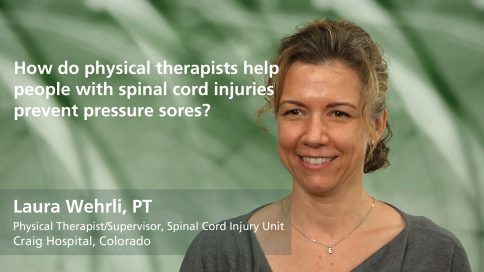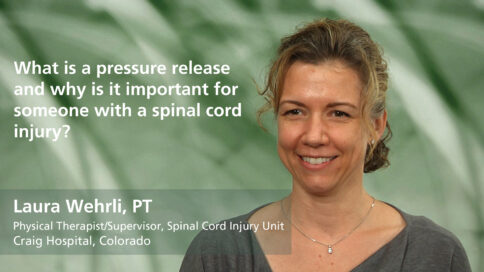Why is pressure relief so important when sitting in a wheelchair? - Mary Zeigler, MS
|
|
Why is pressure relief so important when sitting in a wheelchair? |
|
Mary Zeigler, MSClinical Nurse Specialist, Rehabilitation Institute of Chicago |
||
| Read Bio | More Videos by Mary Zeigler | |
|
Share |
||
Transcript
Pressure reliefs, for someone sitting in a wheelchair, are essential to prevent pressure sores. They should be done approximately every 20 to 30-minutes for a duration of two to three-minutes. When the patient’s in a rehab setting, the physical therapist will instruct them in how to do a variety of different types of reliefs. Depending on the patient’s functional ability, these reliefs do vary. Just for an example, if you are a paraplegic, paralyzed waist down, you can literally sit yourself completely forward; place your arms over a desk, or a table, or even your bed. And what you’re doing is you’re removing all the pressure off your buttocks onto your upper thighs. You can do this in the workplace; you can do this at home. You can also do what we call lateral wheelchair side-pressure reliefs, where you move from one side of the wheelchair, you suspend your arm over the wheelchair’s side rail, and you move like this, and what you’re doing is you are taking the pressure off one buttock at a time. Another option, and this would be appropriate for the paralyzed patient, neck down, is the power chair. The power chair allows the patient to tilt backward, therefore placing all the pressure on the lower back area, or the lumbar spine, and they do this frequently throughout the day.
Show Less|
|
||
add
Why is pressure relief so important when sitting in a wheelchair? |
||
Mary Zeigler, MSClinical Nurse Specialist, Rehabilitation Institute of Chicago |
More Videos by Mary Zeigler | |
| Transcriptadd | share | |
Pressure reliefs, for someone sitting in a wheelchair, are essential to prevent pressure sores. They should be done approximately every 20 to 30-minutes for a duration of two to three-minutes. When the patient’s in a rehab setting, the physical therapist will instruct them in how to do a variety of different types of reliefs. Depending on the patient’s functional ability, these reliefs do vary. Just for an example, if you are a paraplegic, paralyzed waist down, you can literally sit yourself completely forward; place your arms over a desk, or a table, or even your bed. And what you’re doing is you’re removing all the pressure off your buttocks onto your upper thighs. You can do this in the workplace; you can do this at home. You can also do what we call lateral wheelchair side-pressure reliefs, where you move from one side of the wheelchair, you suspend your arm over the wheelchair’s side rail, and you move like this, and what you’re doing is you are taking the pressure off one buttock at a time. Another option, and this would be appropriate for the paralyzed patient, neck down, is the power chair. The power chair allows the patient to tilt backward, therefore placing all the pressure on the lower back area, or the lumbar spine, and they do this frequently throughout the day.





